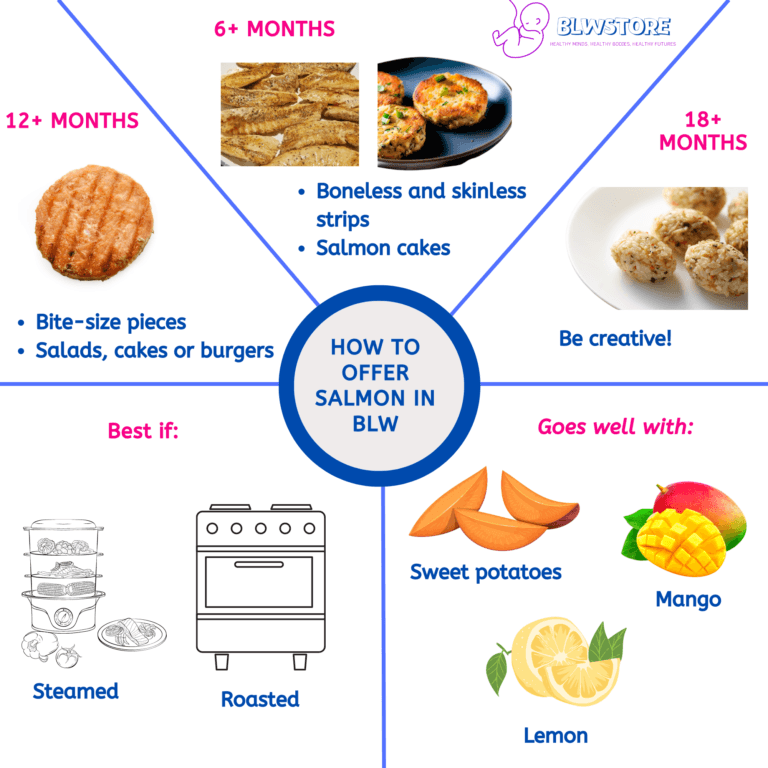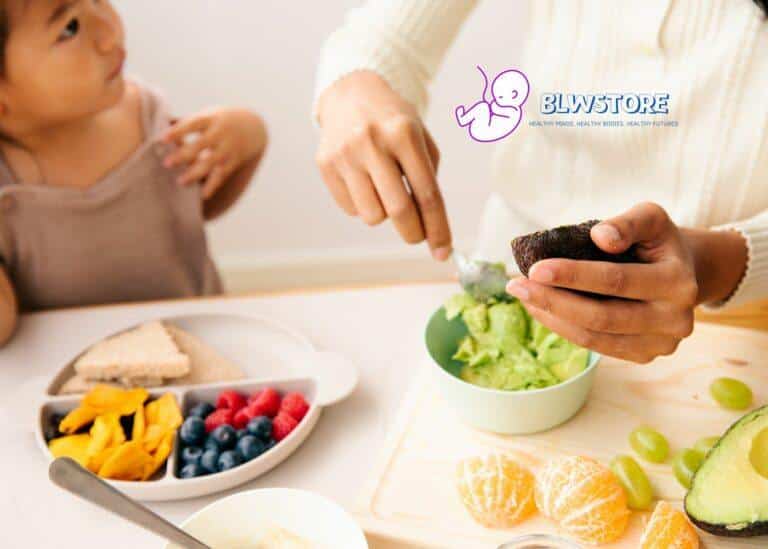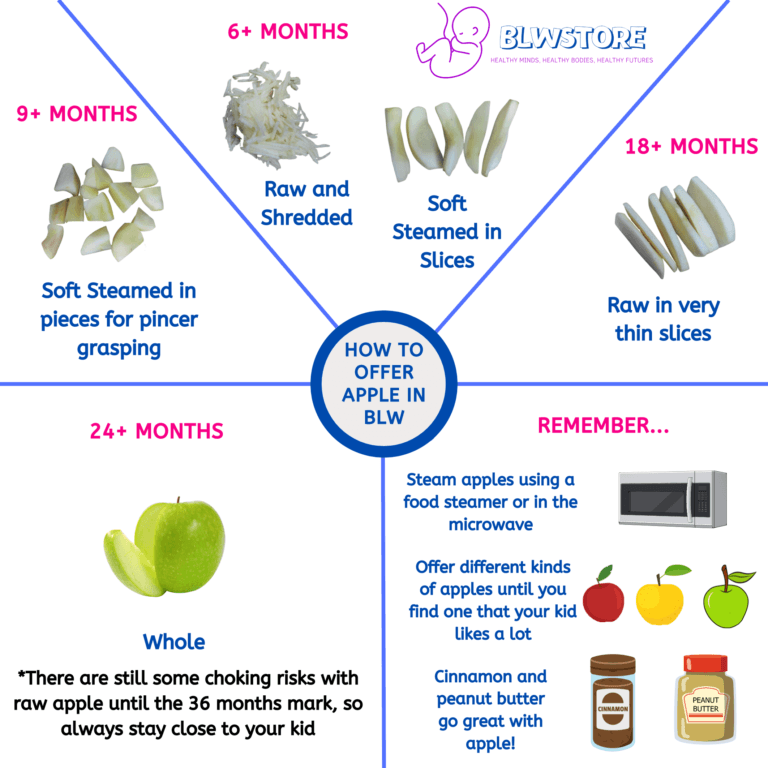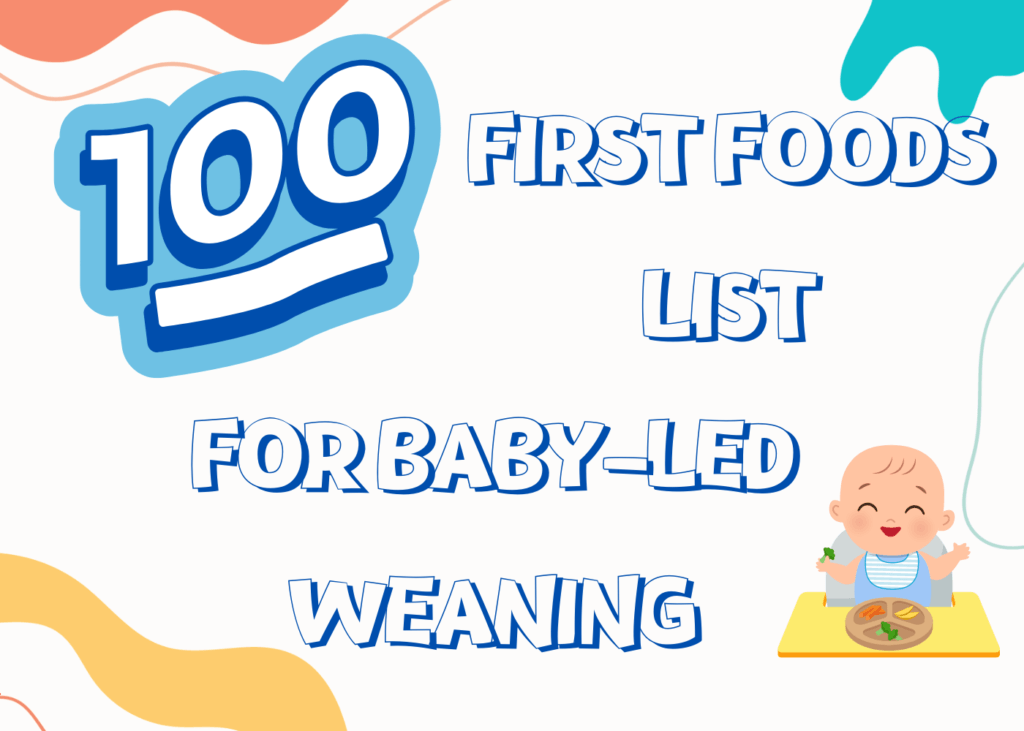
Introducing solid foods is an important milestone for babies.
While traditional spoon-feeding has been the standard approach, Baby-led weaning (BLW) is gaining popularity.
BLW involves offering babies finger foods and allowing them to self-feed.
It is a great way to introduce babies to different foods and textures, promoting the development of fine motor skills.
According to the American Academy of Pediatrics (AAP) and the World Health Organization (WHO), babies should start solid foods, in addition to breast milk, around six months of age.
The first 100 days of introducing solid foods to your baby are crucial, as it sets the foundation for their lifelong eating habits and preferences.
By offering a variety of healthy and nutritious foods, you are helping to shape their taste buds and expand their palates.
Baby-led weaning aims to provide your baby with the best start toward a healthy and well-balanced diet.
This post will give you the first 100 foods for your baby.
If you need a more detailed meal plan to start BLW, check this out.
Let’s get after it!
Start with Iron-Rich Foods
When your little one reaches the ripe age of 6 months, it’s crucial to incorporate iron-abundant sustenance into their diet.
The significance of iron cannot be overemphasized, as it plays a vital role in the growth and maturation of your baby’s brain and overall development.
There are many sources of iron, such as meat, organs (beef liver is the best), and legumes.
It’s worth mentioning that the iron obtained from plant-based foods is not as easily assimilated by the body compared to the iron derived from animal sources.
This is why we recommend an animal-based diet for children.
Thus, joining forces with vitamin C-rich foods is advisable to escalate iron absorption. Examples include citrus fruits, strawberries, and bell peppers.
Balance Protein and Sodium
Protein is critical for your baby’s growth and development, but over-consumption can be harmful. Balance is key, with recommended levels depicted in the picture below.
Protein is a critical component in your baby’s diet, but it is essential to avoid over-consumption. With a delicate balance of nutrients, the right amount of protein is essential for your baby’s growth and development. The recommended levels of protein intake are depicted in the picture below, showcasing the optimal quantities.
It is also crucial to remember that salt content can adversely affect your baby’s health.
With immature kidneys, your baby’s body is not equipped to handle high levels of salt, which can result in harm over time.
Therefore, it is vital to avoid adding salt to their meals and monitor their food’s salt content.
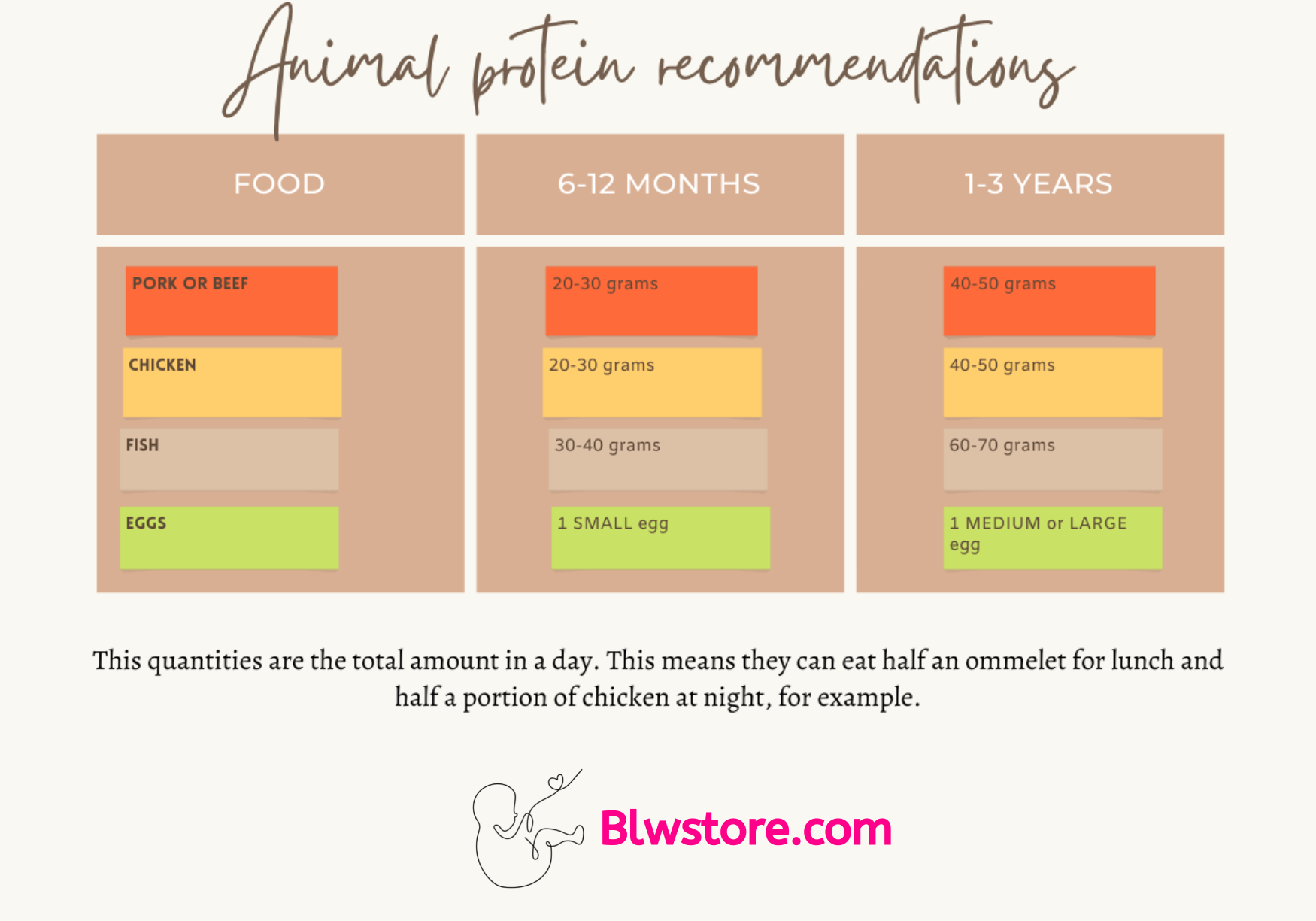
Variety is Key: Introducing New Foods to Your Baby
Introducing new foods to your baby is exciting, but it’s important to go slow and listen to your baby and yourself.
Offer various healthy options and let your baby explore new flavors and textures at their own pace; there’s no rush.
Create a Mealtime Routine with Your Baby
Establishing a mealtime routine can be beneficial for both you and your baby.
Sit down to eat together, create a calming atmosphere, and make mealtime a special bonding moment for the two of you.
This will help tremendously in the future, it has been proven to help on many different levels, including picky eating.
Best Fruits to Start BLW With
| Fruit | Sugars per 100g | Highest Vitamin/Mineral | Calories per 100g |
|---|---|---|---|
| Avocado | NA (Fat) | Vitamin K | 160 |
| Watermelon | 5.5g | Vitamin C | 30 |
| Banana | 12.2g | Potassium | 89 |
| Apple | 10.4g | Vitamin C | 52 |
| Peaches | 9.5g | Vitamin C | 39 |
| Pears | 10.3g | Fiber | 57 |
| Mango | 14.8g | Vitamin A | 60 |
| Papaya | 5.9g | Vitamin C | 43 |
| Kiwi | 8.1g | Vitamin C | 61 |
| Melons | 6.2g | Vitamin C | 34 |
| Plums | 9.2g | Vitamin C | 46 |
| Grapefruit | 6.8g | Vitamin C | 39 |
| Oranges | 9.4g | Vitamin C | 47 |
| Tangerines | 8.3g | Vitamin C | 47 |
| Raspberry | 5.4g | Vitamin C | 52 |
| Cherry | 11.3g | Vitamin C | 50 |
| Pineapple | 9.5g | Vitamin C | 50 |
| Dragonfruit | 11.3g | Vitamin C | 60 |
| Pomegranate | 12.7g | Vitamin C | 83 |
| Guava | 8.9g | Vitamin C | 68 |
| Apricot | 9.0g | Vitamin A | 48 |
| Grape | 15.2g | Resveratrol | 69 |
| Lemon | 2.5g | Vitamin C | 29 |
Best Vegetables for BLW
| Vegetable | Macronutrient | Highest Vitamin/Mineral | Iron (per 100 g) |
|---|---|---|---|
| Artichokes | Carbs | Vitamin K, Folate | Low |
| Sweet Potato | Carbs | Vitamin A, Vitamin C | Medium |
| Carrots | Carbs | Vitamin A, Vitamin K | Low |
| Broccoli | Carbs | Vitamin C, Vitamin K | Medium |
| Cucumber | Carbs | Vitamin K, Potassium | Low |
| Zucchini | Carbs | Vitamin C, Manganese | Low |
| Butternut Squash | Carbs | Vitamin A, Vitamin C | Low |
| Green Beans | Carbs | Vitamin K, Folate | Low |
| Peas | Carbs | Vitamin K, Folate | Medium |
| Bell Peppers | Carbs | Vitamin C, Vitamin A | Low |
| Tomatoes | Carbs | Vitamin C, Vitamin K | Low |
| Eggplant | Carbs | Vitamin K, Nasunin | Low |
| Garlic | Carbs | Vitamin B6, Manganese | Low |
| Onions | Carbs | Vitamin C, Vitamin B6 | Low |
| Sweet Corn | Carbs | Vitamin C, Thiamine | Low |
| Asparagus | Carbs | Vitamin K, Folate | Low |
| Squash | Carbs | Vitamin A, Vitamin C | Low |
| Beets | Carbs | Folate, Manganese | Low |
| Collard Greens | Carbs | Vitamin K, Vitamin A | Medium |
| Brussels Sprouts | Carbs | Vitamin C, Vitamin K | Low |
| Cauliflower | Carbs | Vitamin C, Vitamin K | Low |
| Radishes | Carbs | Vitamin C, Folate | Low |
| Acorn Squash | Carbs | Vitamin C, Vitamin A | Low |
| Spaghetti Squash | Carbs | Vitamin A, Manganese | Low |
| Lima Beans | Carbs | Vitamin K, Folate | Medium |
Meats and Fish for BLW
| Meat | Protein per 100g | Fat per 100g | Iron per 100g |
|---|---|---|---|
| Chicken | 31g | 6g | 1.1mg |
| Turkey | 31g | 6g | 1.1mg |
| Pork Tenderloin | 22g | 6g | 1.5mg |
| Beef Stir Fry | 19g | 9g | 2.5mg |
| Salmon | 20g | 13g | 1.3mg |
| Sardines | 24g | 13g | 3.2mg |
| Light Tuna | 25g | 1g | 0.9mg |
| Trout | 20g | 10g | 2.3mg |
| Herring | 18g | 11g | 1.7mg |
| Shrimp | 20g | 1g | 1.1mg |
| Cod | 19g | 1g | 0.9mg |
| Crab | 18g | 1g | 0.6mg |
| Catfish | 20g | 4g | 1.8mg |
Legumes, nuts, and more
| Food | Protein per 100g | Carbs per 100g | Fat per 100g | Iron per 100g |
|---|---|---|---|---|
| Oatmeal | 11g | 66g | 6g | 2.4mg |
| Lentils | 9g | 20g | 1g | 3.3mg |
| Chickpeas | 9g | 20g | 5g | 2.5mg |
| Tofu | 8g | 2g | 4g | 2.8mg |
| Peanut Butter | 25g | 16g | 49g | 1.9mg |
| Cashews | 18g | 30g | 44g | 4.3mg |
| Chia Seeds | 16g | 44g | 30g | 4.9mg |
| Cinnamon | 3g | 80g | 3g | 6.3mg |
| Eggs | 12g | 1g | 11g | 2.7mg |
| Almond Butter | 6g | 6g | 61g | 0.9mg |
| Olive oil | 0g | 0g | 100g | 0mg |
| Whole Grain Bread | 12g | 52g | 3g | 2.6mg |
| White Rice Cakes | 3g | 89g | 1g | 0.5mg |
| Quinoa Puffs | 9g | 86g | 1g | 0.9mg |
| Overnight Oats | 10g | 30g | 6g | 1.4mg |
| Homemade Tortilla | 7g | 27g | 5g | 1.5mg |
| Chickpea Fritters | 6g | 13g | 21g | 1.7mg |
BLW 100 First Foods FAQ
What is baby-led weaning?
Baby-led weaning (BLW) is a feeding approach that involves offering babies finger foods to encourage self-feeding and the development of fine motor skills.
Instead of spoon-feeding purees, babies are given small pieces of food that they can pick up and explore on their own.
What is the recommended age to start BLW?
The American Academy of Pediatrics and the World Health Organization recommend starting solid foods around six months of age, in addition to breast milk.
What are the best first foods for BLW?
The first foods field guide recommends starter foods such as sweet potatoes, iron-rich foods, peanut butter, and nut butter.
Always introduce appropriate-sized pieces of food and avoid choking hazards like whole nuts or popcorn.
What are the signs of readiness for solid foods?
Babies should be able to sit up in a high chair, have good head control, and show interest in food. They should be able to bring food to their mouth using their hands.
Is BLW safe?
BLW can be safe when appropriate precautions are taken. Always consult with your child’s pediatrician or qualified healthcare provider if your child has a medical condition.
Be aware of choking hazards and avoid foods that are not appropriate for your baby’s age and stage of development.
Can BLW be used for picky eaters?
BLW can be a great way to introduce new foods and textures to picky eaters.
It allows babies to explore new foods at their own pace and can promote a positive relationship with food.
What are some benefits of BLW?
BLW promotes the development of fine motor skills, encourages exploration of new tastes and textures, and can make mealtime more enjoyable for the whole family.
It also promotes responsive feeding, where babies are allowed to self-regulate their intake and choose what they want to eat.
Are there any downsides to BLW?
BLW can be messy and time-consuming, and there is a risk of choking if appropriate precautions are not taken.
It may also be inappropriate for babies with certain medical conditions or developmental delays.
Can BLW be used for older children?
BLW is typically used for babies around six months of age, but it can be started later for older children. You will need to have more patience, depending on the baby.
Where can I find more information about BLW?
Here at Blwstore, we have an extensive archive of articles about Baby Led Weaning, but many other resources are available for BLW, including books, blogs, and free online workshops.
We’re Maria and Alberto, a married couple and educators who are nutrition enthusiasts. Even before we had kids, we were already crazy about nutrition.
We’d read scientific articles, watch videos from nutritionists, and spend hours listening to nutrition podcasts.
Today, we continue doing this, but in a different way, as we’ve learned to sift through the noise and trends. Nutrition, like any other field of knowledge, the more you read and learn, the more you develop a comprehensive understanding of reality, and that’s what has happened to us.
Before having our first child, we focused on learning everything we could about child nutrition, using the same techniques we had already employed, backed by our extensive knowledge in nutrition.
Our mission is to help other parents with their children’s nutrition, to help them become the best versions of themselves.
If we are what we eat and drink, which is absolutely true, let’s do it right!





